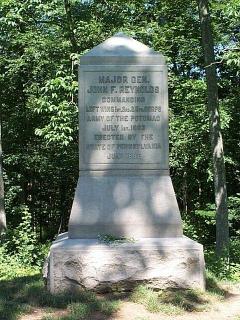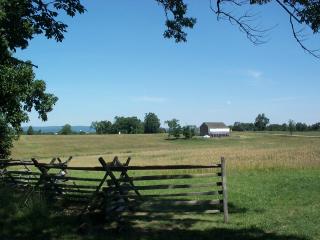

 In June of 1863 Confederate General Robert E. Lee and President Jefferson Davis decided that it was time to take the war to the North. This decision was made because Virginia was being over taxed with the burden of feeding an army as well as the populous of the state. There had already been rioting for flour in the streets of the capitol, Richmond. The goal of this campaign was to capture the goods of the rich farm lands in southern Pennsylvania as well as threaten either; Baltimore, Philadelphia, or Washington D.C. This would bring the Federal Army out into the open and then on ground of the Confederate Army's choosing, win a decisive battle which would bring the government in Washington to the peace table. At the end of June both armies had located each other and were beginning to converge. Federal Brigadier General John Buford's cavalry division was in the lead of the left wing of the Army of the Potomac with instructions to locate and report on the position of the Army of Northern Virginia. Buford's cavalry made contact with the southern army on the evening of June 30th, 1863 northwest of the small farming community of Gettysburg, Pennsylvania. Buford sent word back to Federal Major General John Reynolds, in command of the left wing of the Federal forces, that Buford had located the enemy and that if their enemy got possession of the hills south of the town that the southern army would be difficult to dislodge from that position and that he would try to hold them off as long as possible. Reynolds reply was that he would send help to Buford in the morning. I have read that Confederate Lieutenant General A.P. Hill's Corps believed that shoes were plentiful in Gettysburg and that's why they made for that town on the morning of July 1st. A week earlier a foraging party attached to Confederate Lieutenant General Ewell's Corps had been through that community; emptied and burned several railroad freight cars, rustled up (no pun intended) all the cattle and horses in the area, and removed all the shoes from the shoe factory that was located in Gettysburg. Whether or not a week would have been enough time for the factory to rebuild its shoe inventory seems unlikely, but it does give the cause of the battle of Gettysburg a poignant twist even if its untrue. Hill was under standing orders from General Lee not to provoke a major action, until all the army was up. Hill was not the kind of leader that liked to have his reins pulled in, especially when only a small number of cavalry were between him and his goal. Buford and his cavalry were small in number but not usual. Buford was an old Indian fighter and drove himself and his men hard. Buford's men were armed with Sharps breachloading rifles, giving them many times the fire power of the Rebel's and their muzzleloaders. Buford's troopers held off the first wave of Confederate Brigadier General James Archer's 13th and 5th Alabama regiments. At 8:30am Reynolds arrived on the field, found Buford in the cupola of the Lutheran seminary and asked, "What's the matter John?" "The Devil's to pay," was Buford's discussed reply. "Can you hold for another hour until the 1st Corps arrives?" The old trooper said, "I reckon I can." Now it became a race, a race to see which side could get more troops to the field. Confederate Major General Henry Heth, one of Hill's division commanders, now deployed all of Archer's Brigade on the right and Brigadier General Joseph R. Davis's on the left, thinking that they would now out number and out flank the fast firing Yankee cavalry. Unknown to Heth, the Federal 1st Corps 1st Division was deploying on their front at the double quick. Just after 10:00am as Reynolds was deploying the Iron Brigade, that lead his corps to the battlefield, he saw southern soldiers off to his left in an apple orchard, "Forward, forward men! Drive those fellows out of that! Forward! For God's sake forward!" With that excited order he fell from his horse, face down. An aide that attended him saw a half inch hole behind his right ear, he rolled Reynolds over, the general gasped once, smiled, and he was gone.  The monument to Major General John ReynoldsPresident Lincoln, looking for a replacement for Hooker, asked Reynolds to take over command of the Army of the Potomac. Reynolds declined the offer when he could not be reassured that his command would not be interfered with from Washington. Major General George Gordon Meade, at Reynolds suggestion, was appointed the new commander of the Army of the Potomac three days before the battle of Gettysburg. In the McPhearson Woods stands this monument to Major General John Reynolds.  The McPherson BarnFederal Brigadier General Lysander Cutler's brigade went into position north of Chambersburg Pike, unlike the tree covered position of the Iron Brigade south of the turnpike they were in the open. An unfinished railroad cut ran through their line paralleling the Chambersburg pike. They had barely gotten into position when Davis's rebels advanced on them. Davis's brigade behaved as green as they were. When Colonel John Kerr Connally was shot as he took up the fallen colors of the 55th North Carolina another officer asked if he was badly hurt, "Yes, but pay no attention to me. Take the colors and stay ahead of the Mississippians." By then the whole line was running across the field to see who would hit the Cutler's brigade first. Cutler's brigade wavered and fell back to Seminary Ridge. Davis, the nephew of the southern president, aware of the complaints of nepotism, was elated. Seeing the railroad cut as a way into the rear of the Federals they streamed in, it turned out to be a trap. The cut was too deep to shoot out of. The 6th Wisconsin charged the cut and became masters of the Mississippians gathered helplessly beneath them. When Lieutenant Colonel Dawes arrived at the edge of the cut he heard his Wisconsin men shouting, "Down with your muskets! Put down your muskets!" I have often imagined this scene. In the cut are the Mississippi soldiers, in their ragged uniforms, some perhaps most without shoes. Their bayonet tipped rifles pointed upwards at the Wisconsin boys, whose rifles were pointed down into the cut. Had it been a different time the bottom of the cut would have been lined with the dead but in this war there was some civility. When Dawes yelled at them, "Surrender or I fire." The commander of the 2nd Mississippi Major John A. Blair gave the order, 250 men threw down their guns and surrendered. As I toured this part of the battlefield, I came upon a bridge over some railroad tracks. The tour bus that I had been following stopped right on top of the bridge. I'm sure that I let a string of blue words fly. Why were they stopping here? I can't get around them! Haven't they seen railroad tracks before? It just goes to show how much I knew about the first day's fighting at Gettysburg when I visited there. Had I known I would have taken a couple of pictures looking east and west down those tracks. | ||
 |
 | |